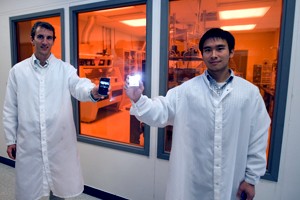
University of Cincinnati researcher on the left holds a current Blackberry device, while the colleague on the right holds a prototype device with electrofluidic display. (Lisa Ventre, Univ. of Cincinnati)
A collaboration between University of Cincinnati’s (UC’s) Novel Devices Laboratory, and startup company Gamma Dynamics LLC, also in Cincinnati, Ohio have created an electrofluidic display that provides a full color, high-impact image at a fraction of the power needed for current color hand-held and tablet devices.
Electrofluidic displays use colored liquids to display the various shades and tints, inserted between two reflective sheets, which can deliver a bright, sharp image without applying voltage. The only electric power needed is to move the liquids into position on the display, but not to project the image itself, which uses instead available light reflected from the display. Purchasers of hand-held or tablet devices today need to chose between low power but limited grayscale display (e.g. Amazon Kindle) and full-color display but needing much more power (e.g., iPhone, iPad).
While this process has been around for a few years, the UC and Gamma Dynamics team developed a method for producing this technology using tools and equipment already available in factories making LCD displays, thus avoiding costly retooling. UC and Gamma Dynamics have filed a patent for their discovery.
The team’s findings are published in the current issue of Applied Physics Letters (paid subscription required). Sun Chemical Corporation in Cincinnati and the global chemical company DuPont also contributed to this project.

 RSS - Posts
RSS - Posts
[…] Science Business and […]